Experimental Study on Thermo-Mechanical Behavior of a Novel Energy Pile with Phase Change Materials Using Fiber Bragg Grating Monitoring
Abstract
:1. Introduction
2. Description of Model Experiments
2.1. Experimental Systems
2.2. Model Piles and Sensor Arrangements
2.3. Calibration of Sensors
2.3.1. Temperature Calibration of FBG
2.3.2. Strain Calibration of FBG
2.4. Phase Change Material
2.5. Tests Procedure
3. Results
3.1. Temperature Change of the Piles
3.2. Thermal Influence Range
3.3. Thermal Strains
3.4. Thermal Stress
3.5. Thermal Friction Resistance
3.6. Pore Water Pressure
3.7. Soil Pressure
4. Discussion
4.1. Thermal Influence of the Piles and Soil
4.2. Data Comparison
4.3. System Error Analysis
5. Conclusions
Author Contributions
Funding
Data Availability Statement
Conflicts of Interest
References
- Brandl, H. Energy foundations and other thermo-active ground structures. Géotechnique 2006, 56, 81–122. [Google Scholar] [CrossRef]
- Moradshahi, A.; Faizal, M.; Bouazza, A.; McCartney, J.S. Effect of nearby piles and soil properties on thermal behaviour of a field-scale energy pile. Can. Geotech. J. 2021, 58, 1351–1364. [Google Scholar] [CrossRef]
- You, S.; Cheng, X.H.; Guo, H.X.; Yao, Z.Q. Experimental study on structural response of CFG energy piles. Appl. Therm. Eng. 2016, 96, 640–651. [Google Scholar] [CrossRef]
- Ren, L.W.; Xu, J.; Kong, G.Q.; Liu, H.L. Field tests on thermal response characteristics of micro-steel-pipe pile under multiple temperature cycles. Renew. Energy 2020, 147, 1098–1106. [Google Scholar] [CrossRef]
- Sutman, M.; Brettmann, T.; Olgun, C.G. Full-scale in-situ tests on energy piles: Head and base-restraining effects on the structural behaviour of three energy piles. Geomech. Energy Environ. 2019, 18, 56–68. [Google Scholar] [CrossRef]
- Laloui, L.; Nuth, M.; Vulliet, L. Experimental and numerical investigations of the behaviour of a heat exchanger pile. Int. J. Numer. Anal. Methods Geomech. 2006, 30, 763–781. [Google Scholar] [CrossRef]
- Faizal, M.; Bouazza, A.; McCartney, J.S. Thermal resistance analysis of an energy pile and adjacent soil using radial temperature gradients. Renew. Energy 2022, 190, 1066–1077. [Google Scholar] [CrossRef]
- Faizal, M.; Bouazza, A.; McCartney, J.S.; Haberfield, C. Effects of Cyclic Temperature Variations on Thermal Response of an Energy Pile under a Residential Building. J. Geotech. Geoenviron. Eng. 2019, 145, 04019066. [Google Scholar] [CrossRef]
- Laloui, L.; Sutman, M. Experimental investigation of energy piles: From laboratory to field testing. Geomech. Energy Environ. 2021, 27, 100214. [Google Scholar] [CrossRef]
- Yang, W.B.; Zhang, L.J.; Zhang, H.; Wang, F.; Li, X.J. Numerical investigations of the effects of different factors on the displacement of energy pile under the thermo-mechanical loads. Case Stud. Therm. Eng. 2020, 21, 100711. [Google Scholar] [CrossRef]
- Murphy, K.D.; McCartney, J.S.; Henry, K.S. Evaluation of thermo-mechanical and thermal behavior of full-scale energy foundations. Acta Geotech. 2015, 10, 179–195. [Google Scholar] [CrossRef]
- Suryatriyastuti, M.E.; Mroueh, H.; Burlon, S. Understanding the temperature-induced mechanical behaviour of energy pile foundations. Renew. Sustain. Energy Rev. 2012, 16, 3344–3354. [Google Scholar] [CrossRef]
- Bourne-Webb, P.J.; Amatya, B.; Soga, K.; Amis, T.; Davidson, C.; Payne, P. Energy pile test at Lambeth College, London: Geotechnical and thermodynamic aspects of pile response to heat cycles. Géotechnique 2009, 59, 237–248. [Google Scholar] [CrossRef]
- Xiong, Z.; Li, X.; Zhao, P.; Zhang, D.; Dong, S. An in-situ experimental investigate of thermo-mechanical behavior of a large diameter over length energy pile. Energy Build. 2021, 252, 111474. [Google Scholar] [CrossRef]
- Alam, M.; Zou, P.; Sanjayan, J.; Ramakrishnan, S. Energy saving performance assessment and lessons learned from the operation of an active phase change materials system in a multi-storey building in Melbourne. Appl. Energy 2019, 238, 1582–1595. [Google Scholar] [CrossRef]
- Kishore, R.A.; Bianchi, M.; Booten, C.; Vidal, J.; Jackson, R. Optimizing PCM-Integrated Walls for Potential Energy Savings in U.S. Buildings. Energy Build. 2020, 226, 110355. [Google Scholar] [CrossRef]
- Oluah, C.; Akinlabi, E.T.; Njoku, H.O. Selection of phase change material for improved performance of Trombe wall systems using the entropy weight and TOPSIS methodology. Energy Build. 2020, 217, 109967. [Google Scholar] [CrossRef]
- Mousavi, S.; Gijon-Rivera, M.; Rivera-Solorio, C.I.; Rangel, C.G. Energy, comfort, and environmental assessment of passive techniques integrated into low-energy residential buildings in semi-arid climate. Energy Build. 2022, 263, 112053. [Google Scholar] [CrossRef]
- Wang, H.; Lu, W.; Wu, Z.; Zhang, G. Parametric analysis of applying PCM wallboards for energy saving in high-rise lightweight buildings in Shanghai. Renew. Energy 2020, 145, 52–64. [Google Scholar] [CrossRef]
- Qi, D.; Pu, L.; Sun, F.T.; Li, Y.Z. Numerical investigation on thermal performance of ground heat exchangers using phase change materials as grout for ground source heat pump system. Appl. Therm. Eng. 2016, 106, 1023–1032. [Google Scholar] [CrossRef]
- Wang, J.L.; Zhao, J.D.; Liu, N. Numerical Simulation of Borehole Heat Transfer with Phase Change Material as Grout. Appl. Mech. Mater. 2014, 577, 44–47. [Google Scholar] [CrossRef]
- Li, X.; Tong, C.; Duanmu, L.; Liu, L. Study of a U-tube heat exchanger using a shape-stabilized phase change backfill material. Sci. Technol. Built Environ. 2017, 23, 430–440. [Google Scholar] [CrossRef]
- Chen, F.; Mao, J.; Li, C.; Hou, P.; Li, Y.; Xing, Z.; Chen, S. Restoration performance and operation characteristics of a vertical U-tube ground source heat pump system with phase change grouts under different running modes. Appl. Therm. Eng. 2018, 141, 467–482. [Google Scholar] [CrossRef]
- Bao, X.; Shazim, M.; Yang, H.; Dong, Z.; Cui, H. Thermal Properties of Cement-Based Composites for Geothermal Energy Applications. Materials 2017, 10, 462. [Google Scholar] [CrossRef] [PubMed]
- Yang, H.B.; Memon, S.A.; Bao, X.H.; Cui, H.Z.; Li, D.X. Design and preparation of carbon based composite phase change material for energy piles. Materials 2017, 10, 391. [Google Scholar] [CrossRef] [PubMed]
- Han, C.; Yu, X.B. An innovative energy pile technology to expand the viability of geothermal bridge deck snow melting for different United States regions: Computational assisted feasibility analyses. Renew. Energy 2018, 123, 417–427. [Google Scholar] [CrossRef]
- Mousa, M.M.; Bayomy, A.M.; Saghir, M.Z. Phase change materials effect on the thermal radius and energy storage capacity of energy piles: Experimental and numerical study. Int. J. Thermofluids 2021, 10, 100094. [Google Scholar] [CrossRef]
- Lee, W.; Lee, W.J.; Lee, S.B.; Salgado, R. Measurement of pile load transfer using the Fiber Bragg Grating sensor system. Can. Geotech. J. 2004, 41, 1222–1232. [Google Scholar] [CrossRef]
- Ge, Y.; Elshafie, M.Z.E.B.; Dirar, S.; Middleton, C.R. The response of embedded strain sensors in concrete beams subjected to thermal loading. Constr. Build. Mater. 2014, 70, 279–290. [Google Scholar] [CrossRef]
- Chen, B.; Maher, M.H.; Nawy, E.G. Fiber-Optic Bragg Grating Sensor for Nondestructive Evaluation of Composite Beams. J. Struct. Eng. 1994, 120, 3456–3470. [Google Scholar] [CrossRef]
- Hill, K.O.; Meltz, G. Fiber Bragg grating technology fundamentals and overview. J. Light. Technol. 1997, 15, 1263–1276. [Google Scholar] [CrossRef]
- Liao, M.; Liang, S.; Luo, R.; Xiao, Y. The cooperative deformation test of an embedded FBG sensor and strain correction curve verification. Constr. Build. Mater. 2022, 342, 128029. [Google Scholar] [CrossRef]
- Chen, F.; Mao, J.; Chen, S.; Li, C.; Hou, P.; Liao, L. Efficiency analysis of utilizing phase change materials as grout for a vertical U-tube heat exchanger coupled ground source heat pump system. Appl. Therm. Eng. 2018, 130, 698–709. [Google Scholar] [CrossRef]
- JGJ94-2008; Technical Code for Building Pile Foundations. Ministry of Housing and Urban-Rural Development of the People’s Republic of China: Beijing, China, 2008.
- Wang, C.L.; Liu, H.L.; Kong, G.Q.; Ng, C.W.; Wu, D. Model tests of energy piles with and without a vertical load. Environ. Geotech. 2016, 3, 203–213. [Google Scholar] [CrossRef]
- Shokouhmand, H.; Kamkari, B. Experimental investigation on melting heat transfer characteristics of lauric acid in a rectangular thermal storage unit. Exp. Therm. Fluid Sci. 2013, 50, 201–212. [Google Scholar] [CrossRef]
- Francesco, F.; Mario, C.S.; Bernardo, F. Convective Effects in a Latent Heat Thermal Energy Storage. Heat Transf. Eng. 2021, 42, 1–22. [Google Scholar] [CrossRef]
- Seddegh, S.; Joybari, M.M.; Wang, X.; Haghighat, F. Experimental and numerical characterization of natural convection in a vertical shell-and-tube latent thermal energy storage system. Sustain. Cities Soc. 2017, 35, 13–24. [Google Scholar] [CrossRef]
- Arıcı, M.; Yıldız, Ç.; Nižetić, S.; Shahsavar, A.; Campo, A. Implications of boundary conditions on natural convective heat transfer of molten phase change material inside enclosures. Int. J. Energy Res. 2021, 45, 7631–7650. [Google Scholar] [CrossRef]
- Chang, H.; Jiang, S.; Wang, H.; Wu, Q.; Zhao, S. Experimental study on the performance of phase change energy storage concrete for energy piles based on Gum Arabic and PEG-600. Geothermics 2023, 114, 102802. [Google Scholar] [CrossRef]
- Yang, W.; Sun, T.; Yang, B.; Wang, F. Laboratory study on the thermo-mechanical behaviour of a phase change concrete energy pile in summer mode. J. Energy Storage 2021, 41, 102875. [Google Scholar] [CrossRef]
- Mousa, M.M.; Bayomy, A.M.; Saghir, M.Z. Experimental and Numerical Study on Energy Piles with Phase Change Materials. Energies 2020, 13, 4699. [Google Scholar] [CrossRef]
- Faizal, M.; Bouazza, A.; Haberfield, C.; McCartney, J.S. Axial and Radial Thermal Responses of a Field-Scale Energy Pile under Monotonic and Cyclic Temperature Changes. J. Geotech. Geoenviron. Eng. 2018, 144, 04018072. [Google Scholar] [CrossRef]
- Lv, Z.X.; Kong, G.Q.; Liu, H.L.; Ng, C.W.W. Effects of Soil Type on Axial and Radial Thermal Responses of Field-Scale Energy Piles. J. Geotech. Geoenviron. Eng. 2020, 146, 06020018. [Google Scholar] [CrossRef]
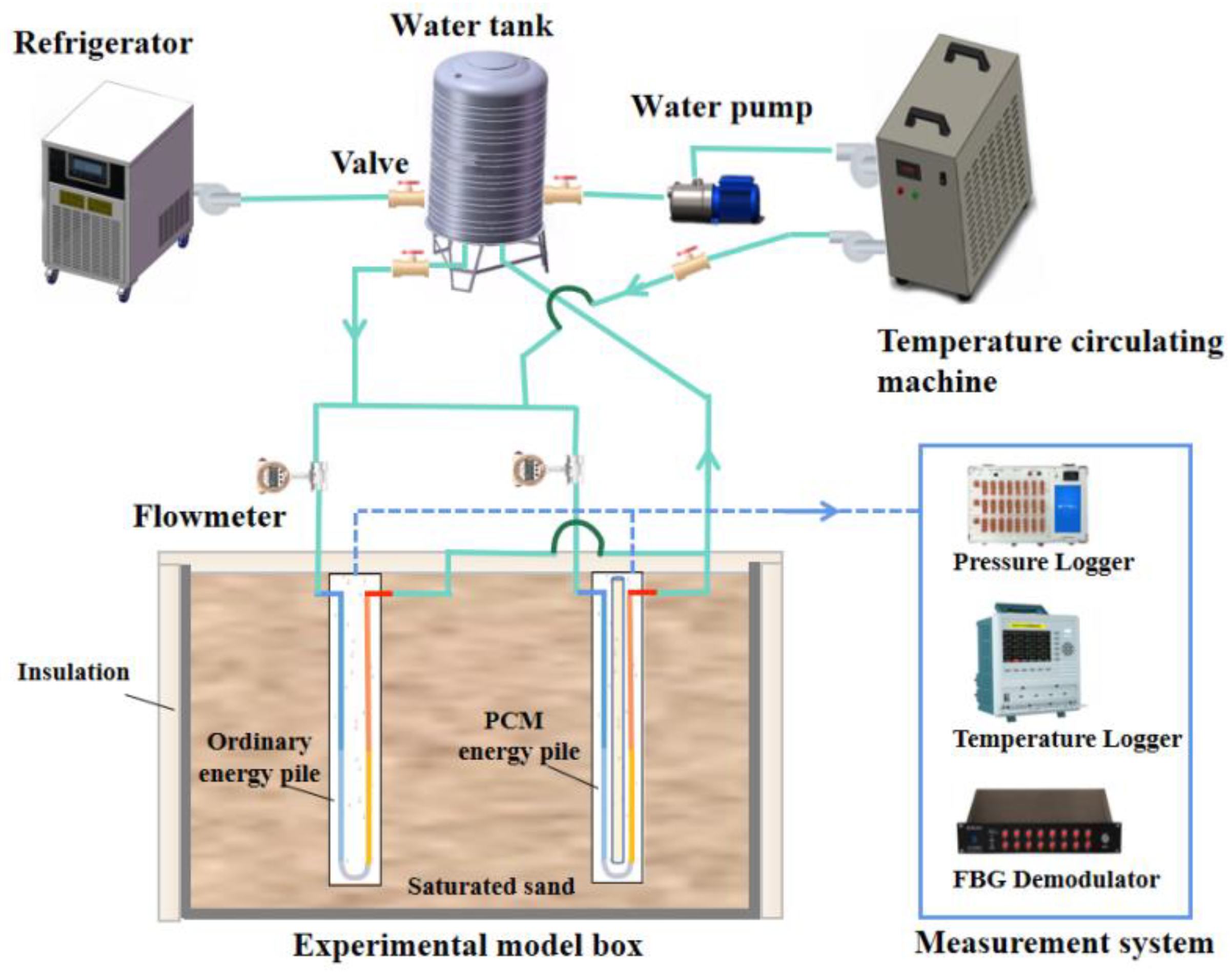



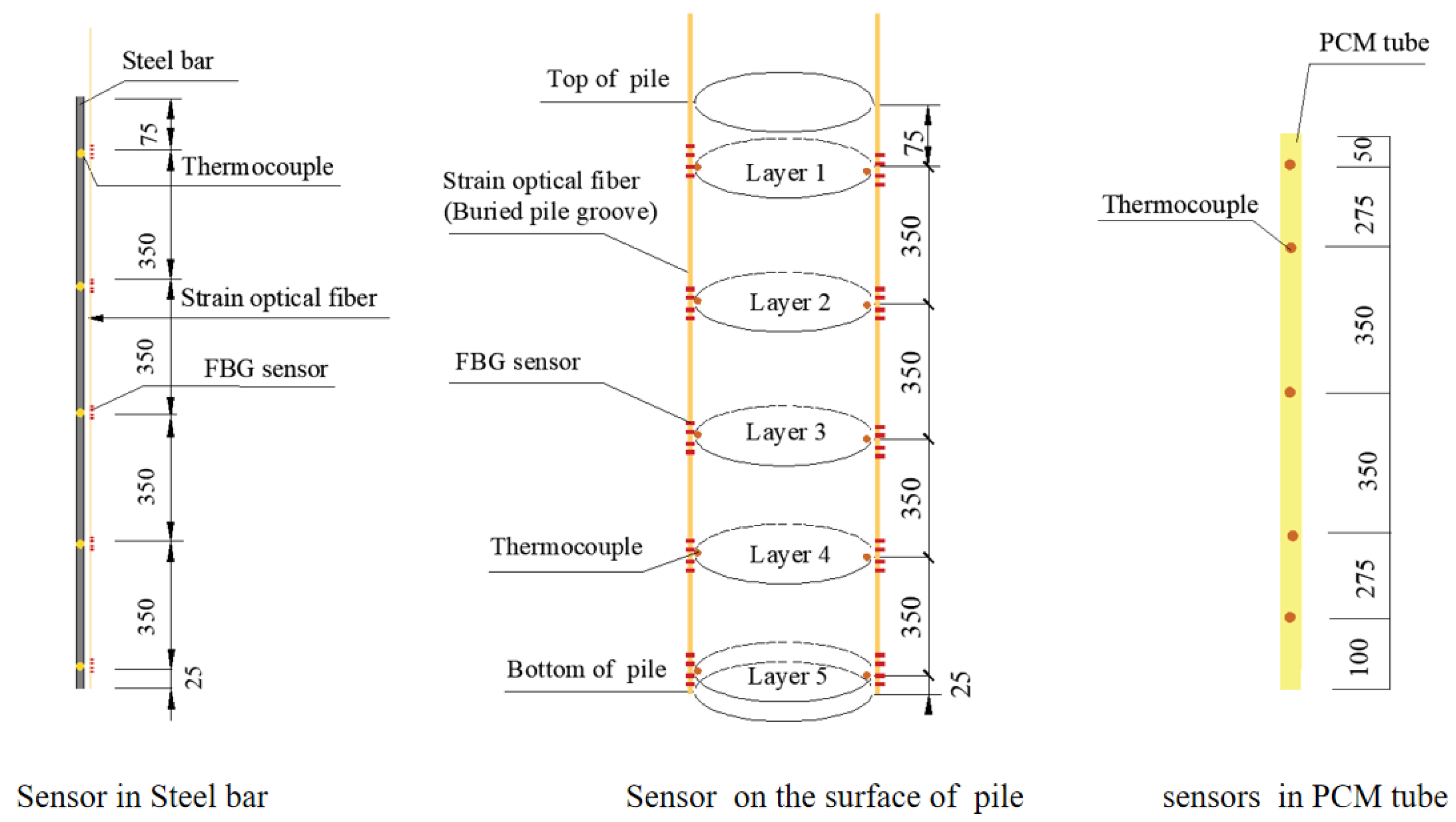




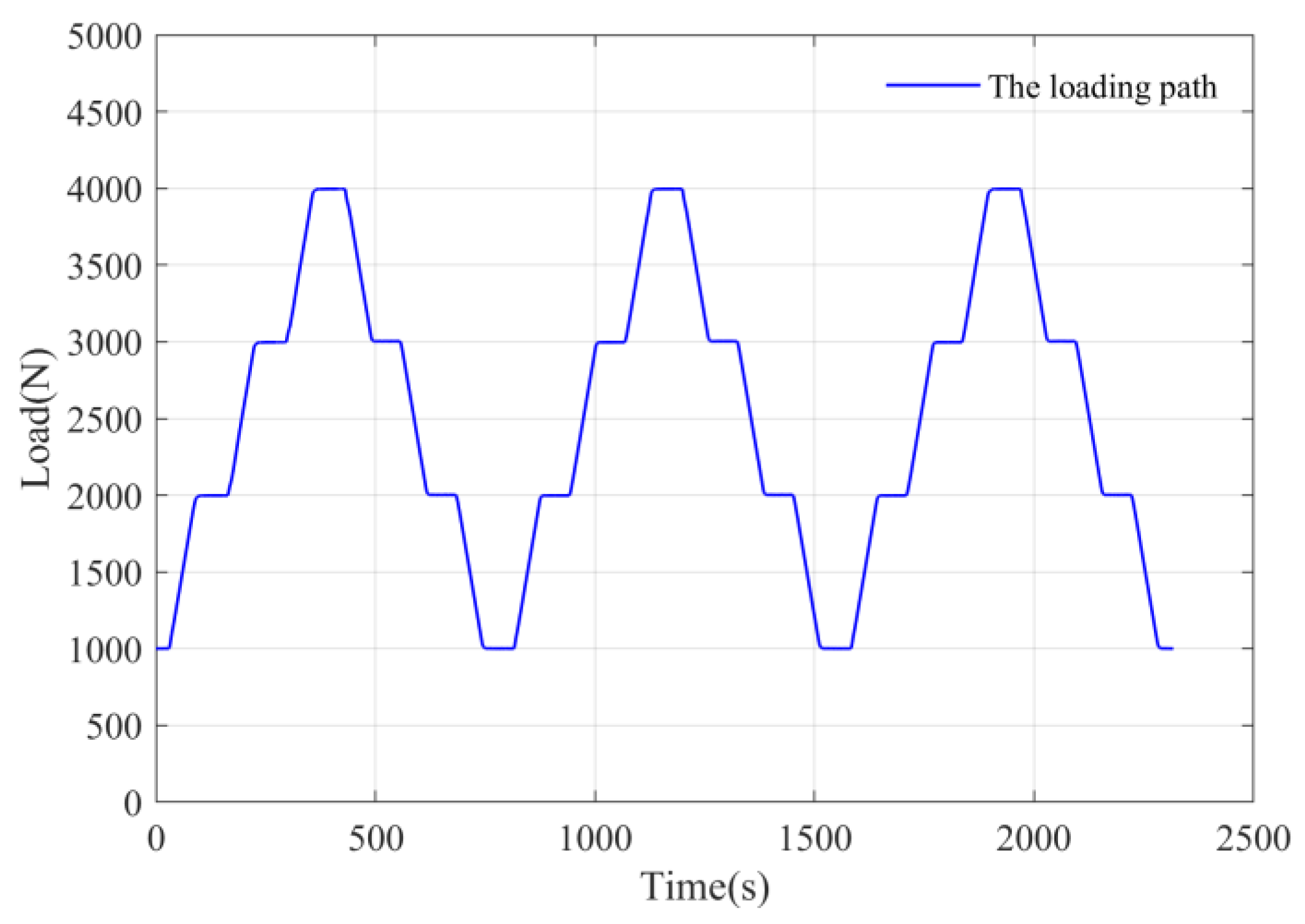


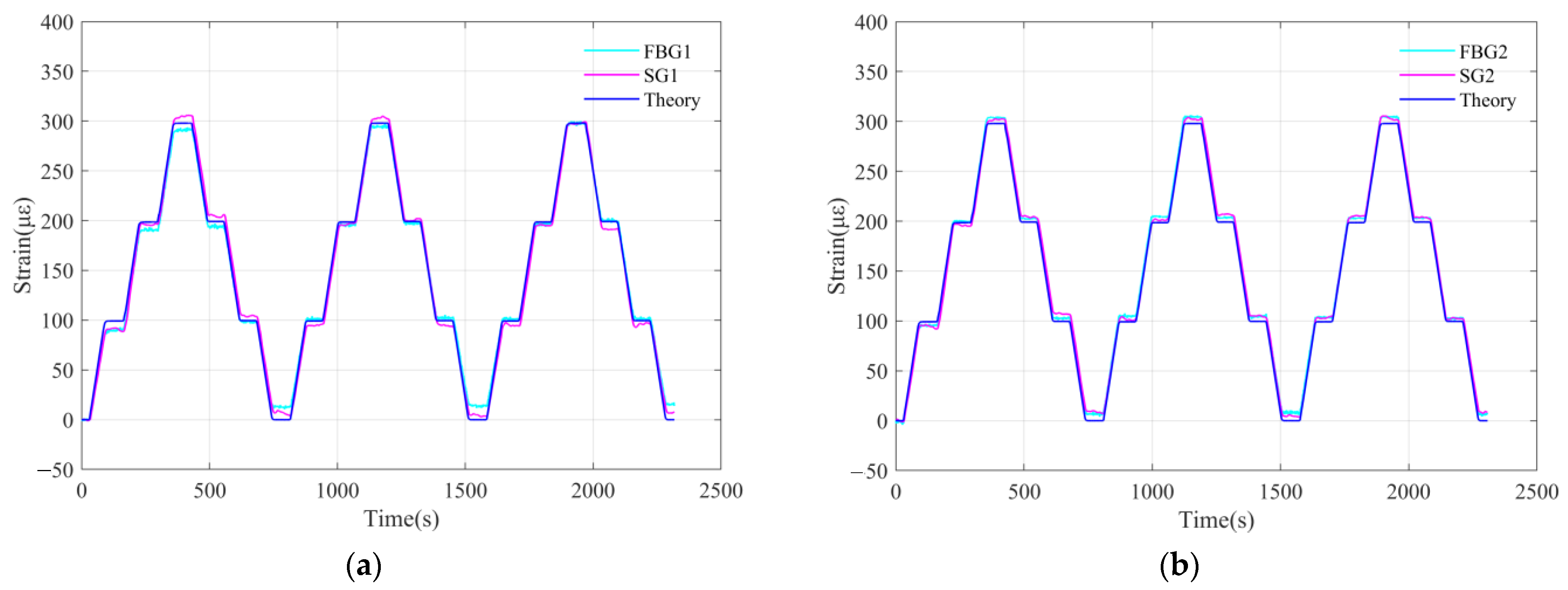




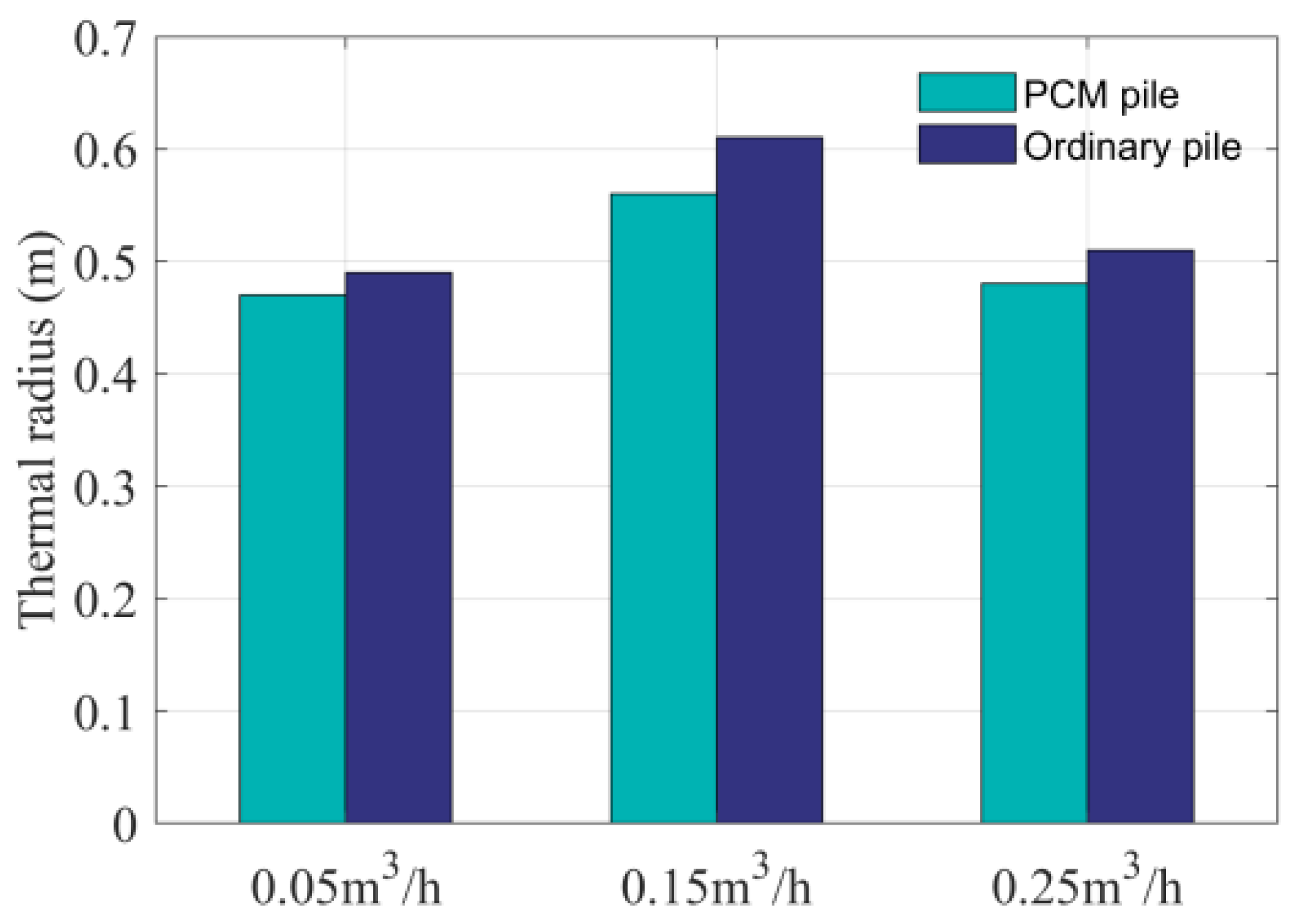


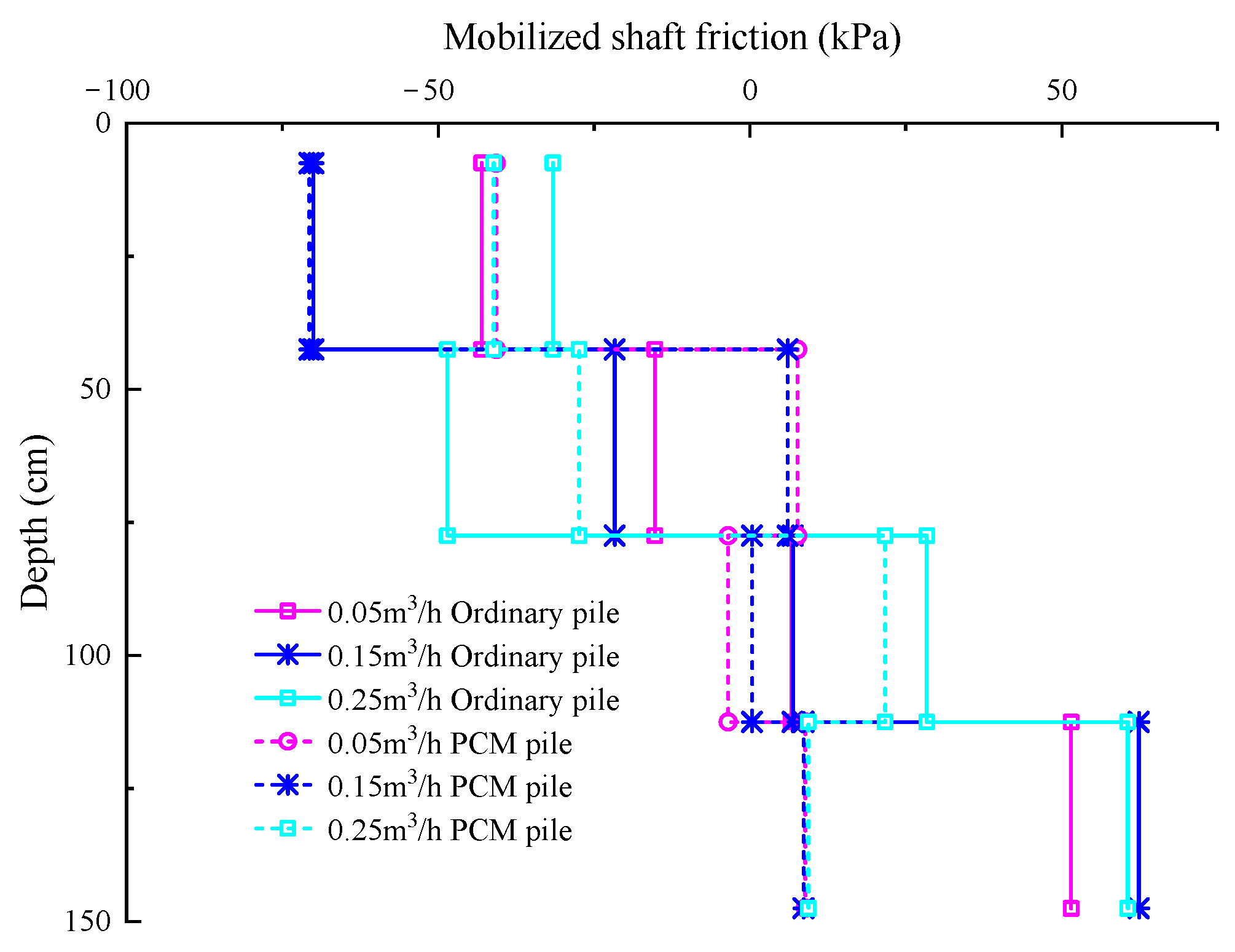

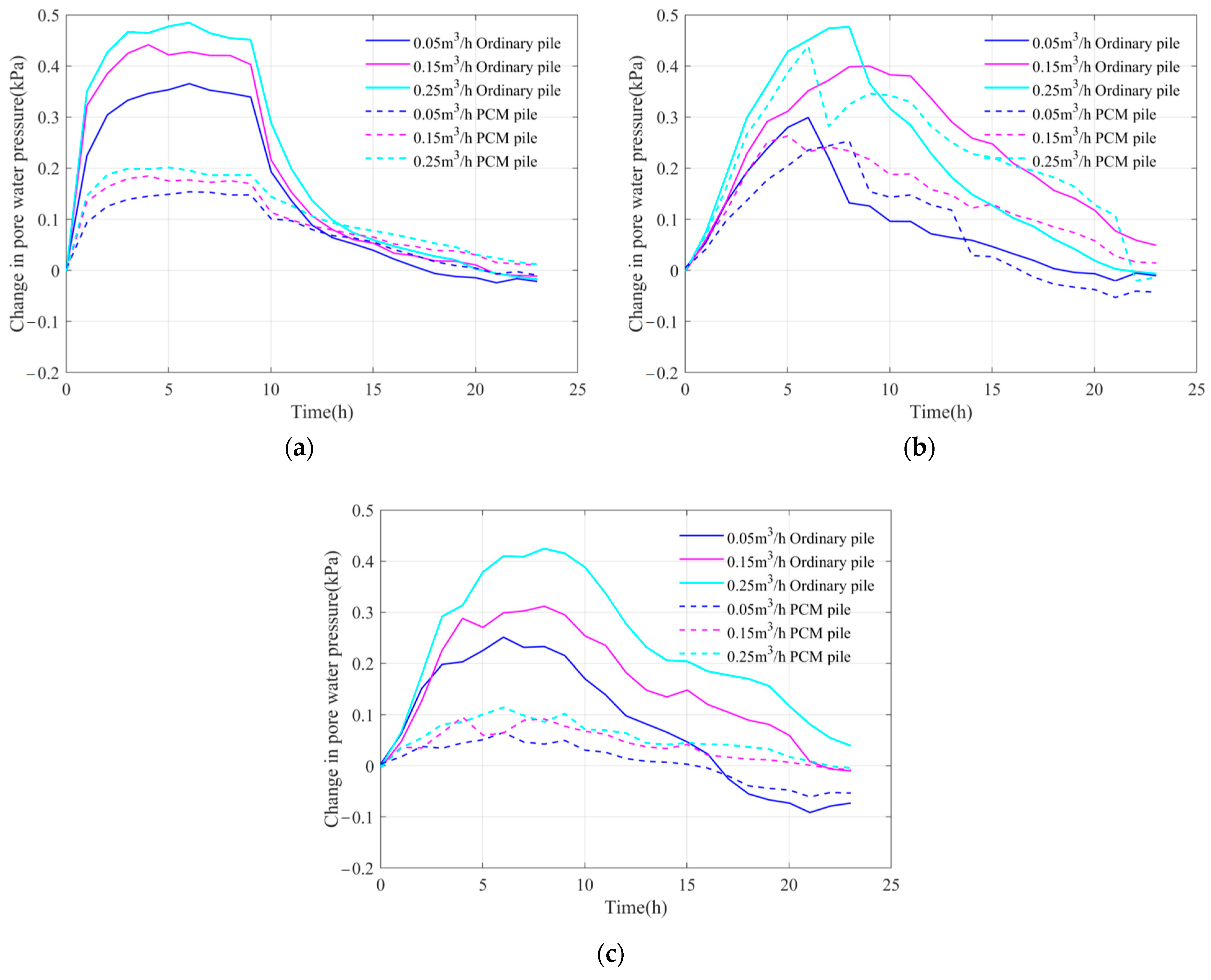

| Mix | Water (kg) | Cement (kg) | Fly Ash (kg) | Sand (kg) | Gravel 5–10 mm (kg) | Gravel 10–19 mm (kg) | Steel Fiber (kg) | Water Reducer (%) |
|---|---|---|---|---|---|---|---|---|
| Plain concrete | 162.8 | 407 | 175 | 649 | 110 | 864 | 0 | 0.25 |
| Steel fiber concrete | 162.8 | 407 | 175 | 649 | 974 | / | 39 | 0.32 |
| Test Points | No. 1 (1533) | No. 2 (1538) | No. 3 (1543) | No. 4 (1548) | No. 5 (1553) | Average |
|---|---|---|---|---|---|---|
| * (nm/°C) | 0.010384 | 0.009893 | 0.010248 | 0.010308 | 0.010362 | 0.01021 |
| Correlation coefficients (R2) | 0.9898 | 0.9983 | 0.9976 | 0.9959 | 0.9959 | 0.9955 |
| Particle Size (mm) | <2 | <1 | <0.75 | <0.25 | <0.1 | <0.075 |
| Percent (%) | 100 | 100 | 79.47 | 39.30 | 1.73 | 0.13 |
| Names | Pile Type | Length (m) | Diameter (m) | Restraints | Soil Layer (m) | (με/°C) | (GPa) | (°C) | (kPa/°C) |
|---|---|---|---|---|---|---|---|---|---|
| Laloui et al. [6] | full-scale pile | 25.8 | 0.96~1.17 | free | Alluvial soil (0–12) Sandy gravelly moraine (12–21.6) Bottom moraine (21.6–25.2) Sandstone (25.2–25.8) | 10 | 29.2 | 20.9 | 104 |
| Faizal et al. [43] | full-scale pile | 16.1 | 0.6 | free | Fill material (0–1.5) Sandy clay (1.5–2.5) Sand (2.5–10) Sand (with traces of clay) (10–16.1) | 12 | 30 | 22 | 106.3 |
| Bourne-Webb et al. [13] | full-scale pile | 30.0 | 0.55~0.61 | free | Fill material (0–1.5) Sand and gravel (1.5–4) Hard clay (4–30) | 8.5 | 40 | 29.4 | 192 |
| Lv et al. [44] | full-scale pile | 24 | 0.6 | free | hard clay (0–24) | 10 | 30.9 | 28.6 | 199.9 |
| Murphy et al. [11] | full-scale pile | 15.2 | 0.61 | Grade beam | sandy fill with silt, gravel (0–1) dense sands, silt, gravel (1–2) Sandstone (2–15.2) | 12 | 30 | 18 | 260 |
| This study | ordinary pile PCM pile | 1.5 1.5 | 0.2 0.2 | free free | Mid-density sand Dr = 0.6 (0–1.5) | 12.05 12.49 | 32.77 37.48 | 12.6 12.2 | 97.5 65.0 |
Disclaimer/Publisher’s Note: The statements, opinions and data contained in all publications are solely those of the individual author(s) and contributor(s) and not of MDPI and/or the editor(s). MDPI and/or the editor(s) disclaim responsibility for any injury to people or property resulting from any ideas, methods, instructions or products referred to in the content. |
© 2023 by the authors. Licensee MDPI, Basel, Switzerland. This article is an open access article distributed under the terms and conditions of the Creative Commons Attribution (CC BY) license (https://creativecommons.org/licenses/by/4.0/).
Share and Cite
Cui, H.; Shi, J.; Li, H.; Xiao, X.; Peng, P.; Bao, X. Experimental Study on Thermo-Mechanical Behavior of a Novel Energy Pile with Phase Change Materials Using Fiber Bragg Grating Monitoring. Sustainability 2024, 16, 206. https://doi.org/10.3390/su16010206
Cui H, Shi J, Li H, Xiao X, Peng P, Bao X. Experimental Study on Thermo-Mechanical Behavior of a Novel Energy Pile with Phase Change Materials Using Fiber Bragg Grating Monitoring. Sustainability. 2024; 16(1):206. https://doi.org/10.3390/su16010206
Chicago/Turabian StyleCui, Hongzhi, Jiaxin Shi, Haixing Li, Xiong Xiao, Peng Peng, and Xiaohua Bao. 2024. "Experimental Study on Thermo-Mechanical Behavior of a Novel Energy Pile with Phase Change Materials Using Fiber Bragg Grating Monitoring" Sustainability 16, no. 1: 206. https://doi.org/10.3390/su16010206
APA StyleCui, H., Shi, J., Li, H., Xiao, X., Peng, P., & Bao, X. (2024). Experimental Study on Thermo-Mechanical Behavior of a Novel Energy Pile with Phase Change Materials Using Fiber Bragg Grating Monitoring. Sustainability, 16(1), 206. https://doi.org/10.3390/su16010206







